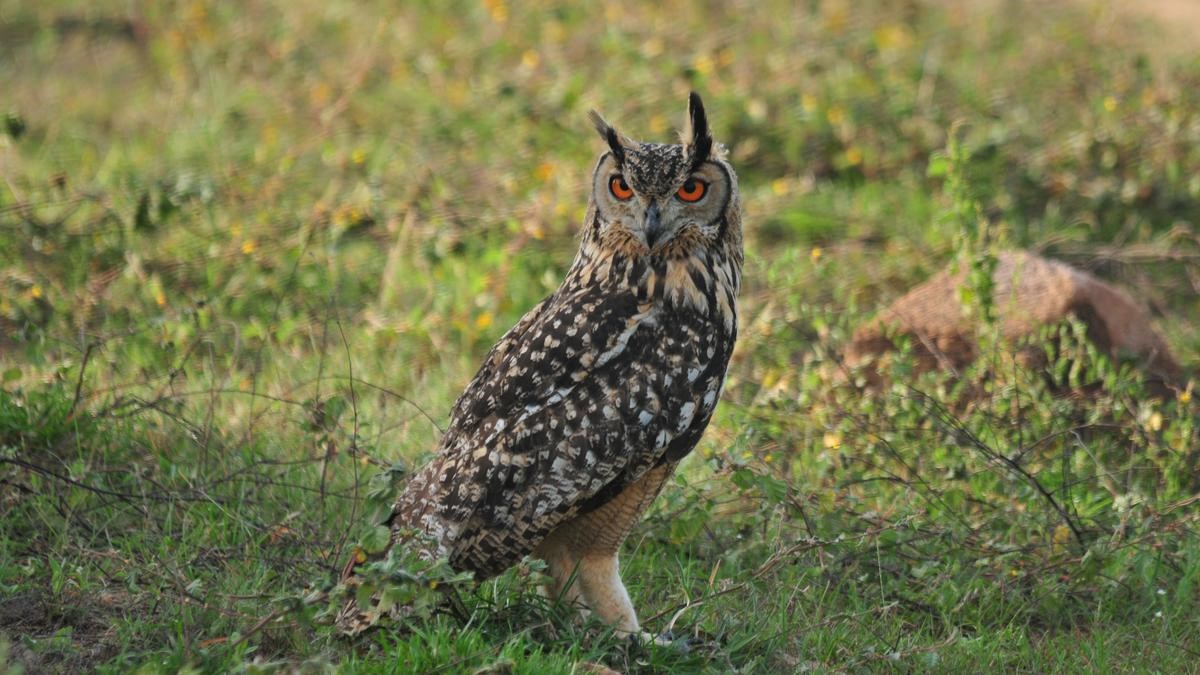Description

Disclaimer: Copyright infringement not intended.
Context
- The Indian eagle-owl (Bubo bengalensis) has recently been recognized as a distinct species, setting it apart from the Eurasian eagle-owl.
- This formidable bird stands as an imposing figure in the avian world, distinguished by its physical attributes, nocturnal behavior, and intriguing cultural significance.
Details
Unique Physical Attributes
Size and Appearance
- The Indian Eagle Owl is one of the largest owl species found in India.
- It boasts a robust build, measuring around 55 to 65 centimeters in length and weighing approximately 1.5 to 2.5 kilograms.
- Its plumage features shades of brown, gray, and black, creating excellent camouflage in its natural environment.
- The female Indian eagle-owl is slightly larger, with a length of up to two and a half feet and a wingspan of six feet.
- The species is characterized by its prominent "ear tufts" that resemble horns, even though they aren't ears.
- Its large, piercing orange or yellow eyes are adapted for low-light conditions, enabling exceptional night vision.
- Striking ear tufts, reminiscent of horns, protrude from its head, possibly serving as a defense mechanism.
Nocturnal Nature
- Its nocturnal habits have contributed to limited knowledge about the species, making it a mysterious and elusive subject for researchers.

Habitat and Range
- Widespread Distribution: Spanning the entire Indian peninsula, the Indian eagle-owl's extensive range suggests a stable population.
- The Indian Eagle Owl is widely distributed across the Indian subcontinent, including India, Nepal, Pakistan, and Sri Lanka.
- This species is not heavily dependent on forests, thriving in open scrublands, agricultural tracts, and rocky perches.
- These owls often inhabit areas with rocky terrain or cliffs that provide suitable nesting sites and vantage points for hunting.
- They are also known to adapt to human-altered landscapes and can be found near villages and agricultural fields.
Myths and Superstitions
- The Indian Eagle Owl holds cultural importance in many regions, often associated with myths, legends, and traditional beliefs.
- In some cultures, the owl's hoot is considered a harbinger of good fortune, while in others, it is seen as an omen of impending danger.
- The Indian eagle-owl carries a cloak of superstition in rural India, often considered a bearer of ill omens due to its loud double-hoot calls.
- Folklore, including stories of an eagle-owl predicting the future in a human voice, adds to its mystical reputation.
Agriculture and Conservation
- Indian eagle-owls contribute to pest control in agricultural areas by preying on rodents, bandicoots, bats, and doves.
- Research reveals healthier owlet populations near agricultural lands, indicating the species' positive impact on farm ecosystems.
Breeding and Nesting
- Breeding season varies based on location, with some populations breeding during winter months.
- Nests are often made in sheltered locations, such as caves, crevices, or abandoned buildings.
- Female Indian Eagle Owls lay around 2 to 3 eggs, and both parents share the responsibility of incubating and raising the chicks.
Conservation Status
- The Indian Eagle Owl is classified as a species of "Least Concern" by the International Union for Conservation of Nature (IUCN).
- However, habitat loss due to urbanization, agricultural expansion, and deforestation remains a threat to their populations.
- Conservation efforts should focus on preserving suitable nesting sites and protecting their diverse habitats.

Conclusion
The Indian eagle-owl emerges as a captivating and intriguing species, merging cultural beliefs, ecological benefits, and a need for conservation. As India's birding community expands its focus to nocturnal species, the Indian eagle-owl may emerge from the shadows of superstition to find its rightful place in the realm of avian research and conservation. In the end, unraveling the mysteries of this majestic owl contributes to our broader understanding of the intricate web of nature and its intersection with human culture.
|
PRACTICE QUESTION
Q. Which of the following statements about the Indian Eagle Owl (Bubo bengalensis) is true?
a) The Indian Eagle Owl is primarily active during the daytime.
b) It is only found in dense forests and jungles.
c) The Indian Eagle Owl has distinctive ear tufts that resemble horns on its head.
d) It feeds exclusively on fish and aquatic creatures.
Answer: c)
|
https://www.thehindu.com/sci-tech/science/the-enigmatic-indian-eagle-owl/article67158707.ece












